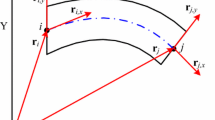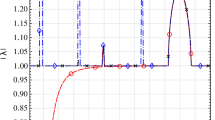Abstract
This paper employs a new finite element formulation for dynamics analysis of a viscoelastic flexible multibody system. The viscoelastic constitutive equation used to describe the behavior of the system is a three-parameter fractional derivative model. Based on continuum mechanics, the three-parameter fractional derivative model is modified and the proposed new fractional derivative model can reduce to the widely used elastic constitutive model, which meets the continuum mechanics law strictly for pure elastic materials. The system equations of motion are derived based on the absolute nodal coordinate formulation (ANCF) and the principle of virtual work, which can relax the small deformation assumption in the traditional finite element implementation. In order to implement the viscoelastic model into the absolute nodal coordinate, the Grünwald definition of the fractional derivative is employed. Based on a comparison of the HHT-I3 method and the Newmark method, the HHT-I3 method is used to solve the equations of motion. Another particularity of the proposed method based on the ANCF method lies in the storage of displacement history only during the integration process, reducing the numerical computation considerably. Numerical examples are presented in order to analyze the effects of the truncation number of the Grünwald series (fading memory phenomena) and the value of several fractional model parameters and solution convergence aspects.
Similar content being viewed by others
References
Hughes, T.J.R., Simo, J.C.: Computational Inelasticity. Springer, New York (1998)
Cortés, F., Elejabarrieta, M.J.: Finite element formulations for transient dynamic analysis in structural systems with viscoelastic treatments containing fractional derivative models. Int. J. Numer. Mech. Eng. 69, 2173–2195 (2007)
Nutting, P.G.: A new general law of deformation. J. Franklin Inst. 191, 679–685 (1921)
Gemant, A.: A method of analyzing experimental results obtained from elasto-viscous bodies. Physics 7, 311–317 (1936)
Leibniz, G.: Leibnizsche Mathematische Schriften. Georg Olm Verlag, Hildesheim (1962)
Kilbas, A.A., Srivastava, H.M., Trujillo, J.J.: Theory and Applications of Fractional Differential Equations. Elsevier, Amsterdam (2006)
Bagley, R.L., Torvik, P.J.: A theoretical basis for the application of fractional calculus to viscoelasticity. J. Rheol. 27(3), 201–210 (1983)
Bagley, R.L., Torvik, P.J.: On the fractional calculus model of viscoelastic behaviors. J. Rheol. 30(1), 133–155 (1986)
Enelund, M., Mähler, L., Runesson, B., Josefson, B.M.: Formulation and integration of the standard linear viscoelastic solid with fractional order rate laws. J. Solids Struct. 36, 2417–2442 (1999)
Padovan, J.: Computational algorithms for FE formulations involving fractional operators. Comput. Mech. 2, 271–287 (1987)
Schmidt, A., Gaul, L.: Finite element formulation of viscoelastic constitutive equations using fractional time derivatives. Nonlinear Dyn. 29, 37–55 (2002)
Galucio, A.C., Deü, J.F., Ohayon, R.: Finite element formulation of viscoelastic sandwich beams using fractional derivative operators. Comput. Mech. 33, 282–291 (2004)
Deü, J.F., Galucio, A.C., Ohayon, R.: Dynamic responses of flexible-link mechanisms with passive active damping treatment. Comput. Struct. 86, 258–265 (2008)
Shabana, A.A.: Flexible multi-body dynamics review of past and recent developments. Multibody Syst. Dyn. 1, 189–222 (1997)
Shabana, A.A.: An absolute nodal coordinates formulation for the large rotation and deformation analysis of flexible bodies. Technical Report. No. MBS96-1-UIC, University of Illinois at Chicago (1996)
Shabana, A.A.: Definition of the slopes and absolute nodal coordinate formulation. Multibody Syst. Dyn. 1, 339–348 (1997)
Shabana, A.A.: Dynamics of Multibody Systems, 3rd edn. Cambridge University Press, New York (2005)
Eberhard, P., Schiehlen, W.: Computational dynamics of multibody systems history, formalisms, and applications. ASME J. Comput. Nonlinear Dyn. 1, 3–12 (2006)
Yoo, W.S., Dmitrochenko, O., Yu, D.: Review of finite elements using absolute nodal coordinates for large-deformation problems and matching physical experiments. In: Proceedings of the ASME DETC Conference, California, Long Beach, DETC2005-84720
JongHwi, S., SeokWon, K., IlHo, J., TaeWon, P., JinYong, M., YoungGuk, K., JangBom, C.: Dynamic analysis of a pantograph–catenary system using absolute nodal coordinates. Veh. Syst. Dyn. 44(8), 615–630 (2006)
Gerstmayr, J., Shabana, A.A.: Analysis of thin beams and cables using the absolute nodal coordinate formulation. Nonlinear Dyn. 5, 109–130 (2006)
Shabana, A.A., Maqueda, L.G.: Slope discontinuities in the finite element absolute nodal coordinate formulation: gradient deficient elements. Multibody Syst. Dyn. 20, 239–249 (2008)
Romero, I.: A comparison of finite elements for nonlinear beams: the absolute nodal coordinate and geometrically exact formulations. Multibody Syst. Dyn. 20, 51–68 (2008)
García-Vallejo, D., Mayo, J., Escalona, J.L., Domínguez, J.: Three-dimensional formulation of rigid-flexible multibody systems with flexible beam elements. Multibody Syst. Dyn. 20, 1–28 (2008)
García-Vallejo, D., Valverde, J., Domínguez, J.: An internal damping model for the absolute nodal coordinate formulation. Nonlinear Dyn. 42, 347–369 (2005)
Shabana, A.A.: Computational Continuum Mechanics. Cambridge University Press, New York (2008)
Zhang, W., Shimizu, N.: FE formulation for the viscoelastic body modeled by fractional constitutive law. Acta Mech. Sin. 17(4), 354–365 (2001)
Omar, A., Shabana, A.A.: A two-dimensional shear deformable beam for large rotation and deformation problems. J. Sound Vib. 243(3), 565–576 (2001)
García-Vallejo, D., Mayo, J., Escalona, J.L.: Efficient evaluation of the elastic forces and the Jacobian in the absolute nodal coordinate formulation. Nonlinear Dyn. 35, 313–329 (2004)
Gerstmayr, J., Shabana, A.A.: Efficient integration of the elastic forces and thin three-dimensional beam elements in the absolute nodal coordinate formulation. In: ECCOMAS Thematic Conference, Madrid, Spain, 21–24 June 2005
Newmark, N.M.: A method of computation for structural dynamics. ASCE J. Eng. Mech. Div. 67–94 (1959)
Fung, T.C.: Complex-time-step Newmark methods with controllable numerical dissipation. Int. J. Numer. Methods Eng. 41, 65–93 (1998)
Gerstmayr, J., Matikainen, M.K., Mikkola, A.M.: A geometrically exact beam element based on the absolute nodal coordinate formulation. Multibody Syst. Dyn. 20, 287–306 (2008)
Géradin, M., Rixen, D.: Mechanical Vibrations: Theory and Applications to Structural Dynamics. Wiley, New York (1997)
Negrut, D., Rampalli, R., Ottarsson, G., Sajdak, A.: On an implementation of the Hilber–Hughes–Taylor method in the context of index 3 differential-algebraic equations of multibody dynamics. ASME J. Comput. Nonlinear Dyn. 2(1), 73–85 (2007)
Hussein, B., Negrut, D., Shabana, A.A.: Implicit and explicit integration in the solution of the absolute nodal coordinate differential/algebraic equations. Nonlinear Dyn. 54, 283–296 (2008)
Maqueda, L.G., Shabana, A.A.: Poisson modes and general nonlinear constitutive models in the large displacement analysis of beams. Multibody Syst. Dyn. 18, 375–396 (2007)
Sopanen, J.T., Mikkola, A.M.: Description of elastic forces in absolute nodal coordinate formulation. Nonlinear Dyn. 34, 53–74 (2003)
García-Vallejo, D., Mikkola, A.M., Escalona, J.L.: A new locking-free shear deformable finite element based on absolute nodal coordinates. Nonlinear Dyn. 50, 249–264 (2007)
Author information
Authors and Affiliations
Corresponding author
Additional information
An erratum to this article can be found at http://dx.doi.org/10.1007/s11044-008-9142-2
Rights and permissions
About this article
Cite this article
Zhang, Y., Tian, Q., Chen, L. et al. Simulation of a viscoelastic flexible multibody system using absolute nodal coordinate and fractional derivative methods. Multibody Syst Dyn 21, 281–303 (2009). https://doi.org/10.1007/s11044-008-9139-x
Received:
Accepted:
Published:
Issue Date:
DOI: https://doi.org/10.1007/s11044-008-9139-x




